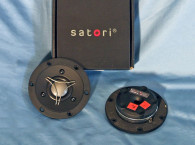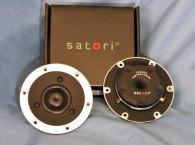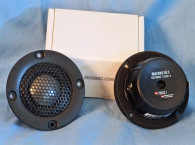




Features include a 29 mm, 8 mm wide surround coated cloth-type diaphragm, a non-reflective cast-aluminum rear cavity, a two-part aluminum faceplate with integrated mechanical decoupling, dual-balanced compression chambers, a high-saturation neodymium ring type motor magnet with a T-shaped pole and dual copper shorting rings (Faraday shields), a CCAW wound voice coil, foam mounting gasket, and gold-plated terminals.
Testing commenced using the LinearX LMS analyzer to produce the 300-point impedance sweep illustrated in Figure 1. The tweeter resonance occurs at a moderately low 624 Hz. With a 6.10 Ω DCR (Re), the minimum impedance for this tweeter is 6.53 Ω at 3.58 kHz. Following the impedance test, I recess-mounted the SB tweeter in an enclosure with a baffle area of 17” × 8” and measured the on- and off-axis frequency response again using the Loudsoft FINE R+D analyzer (provided to Voice Coil by Loudsoft) and GRAS 46BE 1/4” microphone were set up to measure the 200 Hz to 40 kHz frequency response (using a 192 kHz sampling rate) at 2 V/0.5 m normalized to 2.83 V/1 m. Sweeps were performed at 0°, 15°, 30°, and 45°. Figure 2 shows the on-axis response of the TW29DN-B, which measured ±1.4 dB from 1.5 kHz to 11 kHz, followed by a 5 dB rise between 11 kHz to 30 kHz.
Figure 3 gives the on- and off-axis response of the TW29DN-B-8 Satori tweeter. Figure 4 shows the off-axis curves normalized to the on-axis response. Figure 5 shows the CLIO 180° polar plot (measured in 10° increments with 1/3 octave smoothing). Figure 6 shows the two-sample SPL comparison of the SB Acoustics TW29DN-B-8, indicating the two samples were closely matched to within 0.5 to 1 dB throughout its operating range.




For the final group of tests, I again fired up the Listen SoundCheck analyzer along with the Listen SCM 2 1/4” microphone and measured the impulse response with the tweeter recess mounted on the same 17” × 8” test baffle. Importing this data into the Listen SoundMap software produced the CSD waterfall plot shown in Figure 7. Figure 8 is a STFT displayed as a surface plot.
For the final test procedure, I set the 1 m SPL to 94 dB (3 V) using a noise stimulus, and measured the second and third harmonic distortion at 10 cm (see Figure 9).

The build quality of the Satori line is definitely appropriate to the high-end two-channel market. I know that Danesian Audio (Frank and Ulrik) listen obsessively to various iterations of a driver as they go through the development process, so I have no doubt that this tweeter performs admirably. For more information on the SB Satori TW29DN-B and other SB Acoustics drivers, visit www.sbacoustics.com. VC
This article was published in Voice Coil, March 2019.







